
The Silent Killers of SAAS Marketing Success [CHALLENGES]: Can Your Brand Survive?
The software-as-a-service (SaaS) industry has experienced booming growth in the last few years. Global spending on cloud-based software services is expected to reach over $819.23 billion by 2030. Fueling this growth is an increasing demand for mobile apps, continued adoption of cloud computing, and the need for businesses to automate their operations.
As more companies adopt flexible subscription models for essential business tools, the opportunity for SaaS providers to turn startups into unicorns has never been greater. However, with opportunity comes increased competition.
A solid marketing strategy has become the key differentiator for SaaS companies wanting to succeed.
Why?
Because it can help these companies gain traction and stand out in today’s fiercely competitive digital space. To zoom ahead of the competition, you need the right SaaS marketing agency to clearly communicate your products' value proposition, target the right audiences, and grow worthwhile marketing qualified leads (MQLs) and sales qualified leads (SQLs).
Even the best marketing strategies and the savviest of SaaS marketers can be derailed by a number of oft-overlooked challenges, however.
From lack of buyer insights and content overload to managing customer expectations, SaaS brands face many threats to their marketing success.
This article covers seven hidden challenges that can stand in the way of your SaaS marketing success. It will also provide crucial strategies to address and overcome these SaaS marketing challenges.
The Unique Nature of SaaS Marketing
SaaS marketing is vastly different from traditional product marketing in several ways.
Unlike traditional physical products, SaaS offerings are intangible. Therefore, software companies must keep a consistently strong focus on building robust customer relationships as well as delivering ongoing value. Instead of banking on physical features, your marketing strategy should focus on the benefits and value that your software solution provides.
Customer retention and churn reduction take center stage in SaaS marketing. Why is this true? Unlike traditional product marketing tactics, where the sale is often a one-time transaction, SaaS brands rely on recurring revenue from subscription-based models.
Traditional product marketing puts the most effort and resources towards pushing potential customers into the sales funnel. That makes marketing feel like a one-and-done process, a piece in the grand scheme of sales and the buyer’s journey.
SaaS marketing strongly emphasizes building long-term customer relationships and maximizing each client's lifetime value (LTV). To create a sense of trust and reliability, marketers must continually showcase how their SaaS solutions can be instrumental in the customer's journey toward success.
SaaS marketing should place a concentrated focus on consistent communication with both prospects and existing customers. Personalized service, proactive customer success management, ease of access, and rapid effective responses when problems arise ensure customers’ continued confidence that they are getting the most value from your solutions.
SaaS marketers should remember to observe marketing fundamentals in the midst of this process. They must conduct ongoing top-down research on their target audience, especially the decision-makers, and their pain points.
SaaS marketing relies heavily on data and analytics to help marketers remain current about their customer characteristics. They must also identify which key performance indicators are the best to use for measuring the success of their SaaS marketing campaigns.
Top SAAS Marketing Challenges
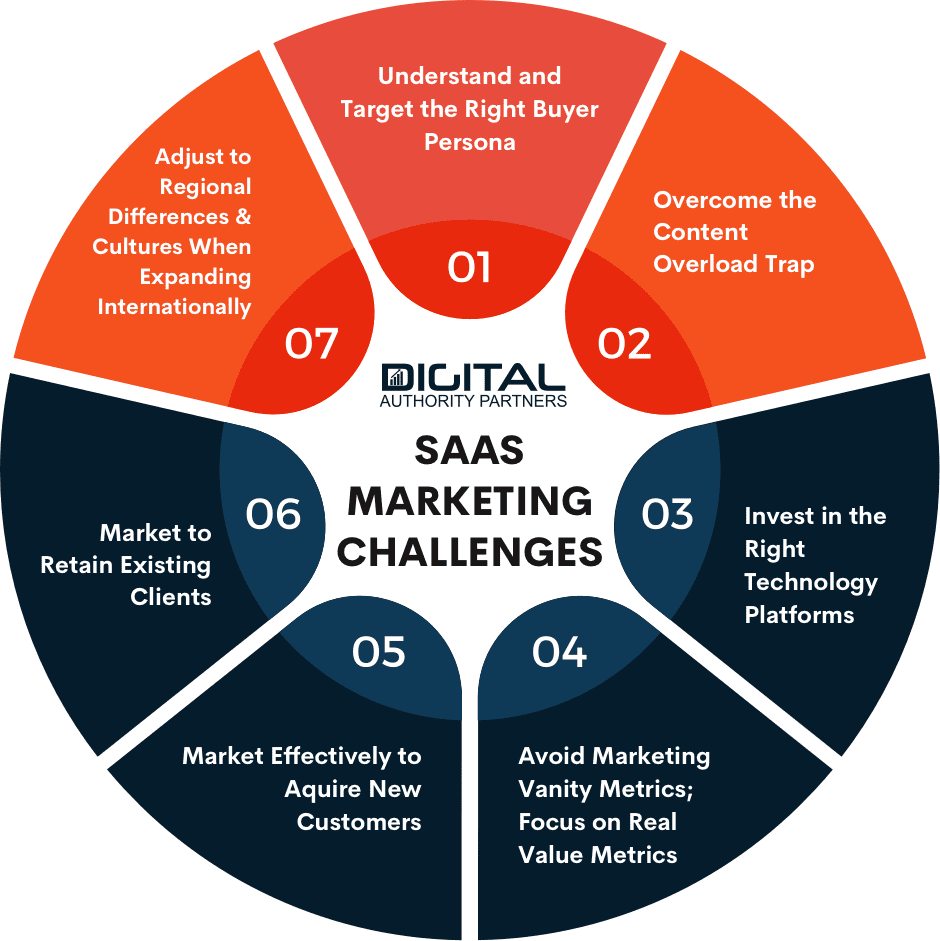
The SaaS industry has its own unique requirements and quirks. Paying careful attention to these nuances when optimizing your marketing strategy will pay off in happy customers.
Fierce competition from the hundreds of brands that could offer similar services can make the enterprise cycle take months, if not years, before a contract is signed.
However, a well-executed marketing strategy can help SaaS companies stand out from the competition, acquire new customers, and achieve their desired MQL growth. Even with an impeccable strategy, some challenges can stand in the way of achieving your goals.
When defining a marketing and sales strategy, finding keywords, and setting a buyer persona, marketers need to remember another point: who are the true decision-makers? Determining who these people are within target accounts presents another hurdle, especially when working with large firms. In the realm of B2B SaaS products, enterprise cycles, and critical decisions often involve multiple stakeholders from various departments.
For instance, marketing teams may assume the IT director holds the primary decision-making power while overlooking the crucial approval of the CFO. Failing to engage all influencers and decision-makers can lead to stalled deals.
1. Understanding and Targeting the Right Buyer Persona (Audience)
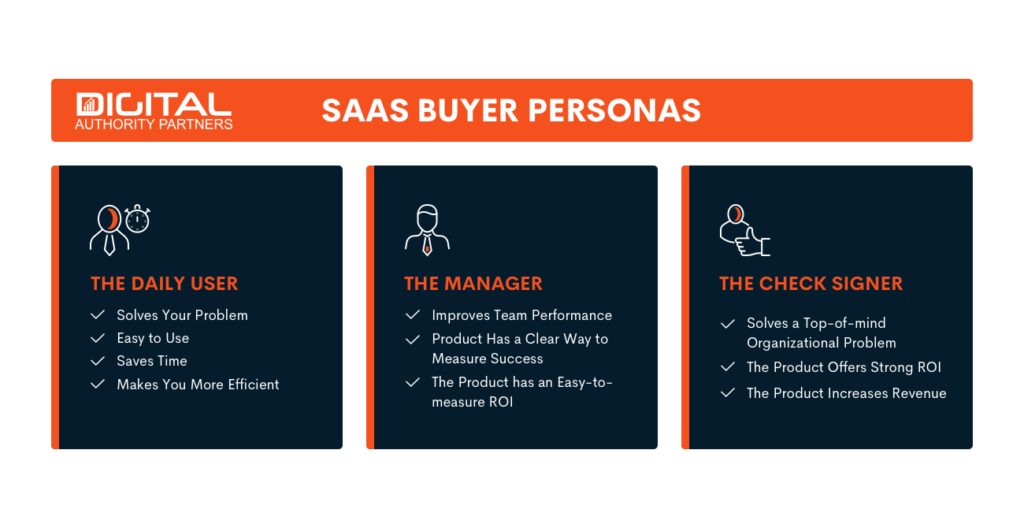
As mentioned, targeting the right audience is critical to a successful SaaS marketing campaign. It is also one of the most significant challenges for many SaaS marketing experts. Defining the target buyer persona, in particular, is one of the most daunting hurdles SaaS brands face.
Clearly defining your typical buyer persona's wants, needs, and problems is the cornerstone of an effective SaaS marketing roadmap. You can leverage tools and best practices to ensure you clearly understand what your target audience wants so that you can appropriately tailor your campaigns to meet those needs best.
SaaS startups and small and medium-sized businesses (SMBs) can find this process especially difficult because they might not have the expertise or resources to conduct effective market research in order to identify their ideal target market and buyer personas correctly.
This crucial first step requires extensive research, repeated testing to refine the audience, and other well-executed SaaS SEO tactics. These personas must go beyond basic demographics. Solid research will delve into the mindsets, concerns, and goals of the ideal buyer persona. When adequately determined, these traits are then employed to create messaging and content that resonates on an emotional level with that ideal buyer. Inaccuracies at this stage could be fatal.
A related step in the information-gathering process includes keyword research to identify the phrases and search terms prospects use to find the services you offer. This, along with a correct buyer persona, form the fundamental B2B SaaS SEO points you will adopt as part of optimizing your digital assets for SEO.
2. Overcome the Content Overload Trap
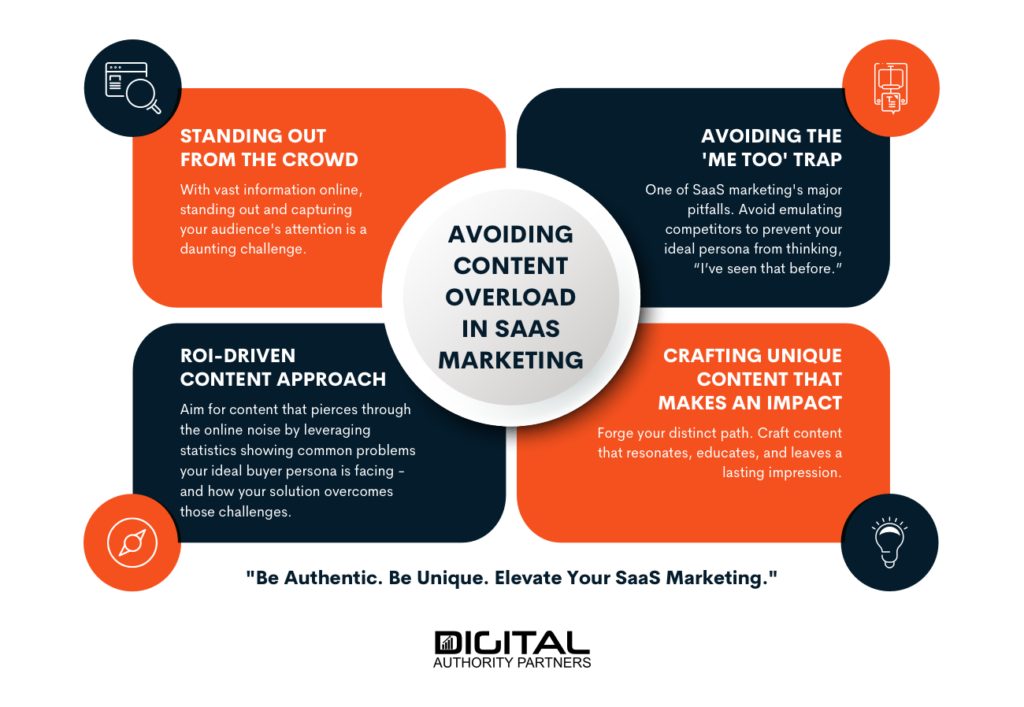
When you have uncovered the real influencers, buyers, and decision-makers through stakeholder analysis and account mapping, crafting a compelling content strategy is the next step. Your content should be engaging, helpful, and resonate well with your target audience while addressing their problems, challenges, and needs.
Regularly producing and publishing engaging and relevant content is an important task every SaaS marketer should do. But that is easier said than done!
This brings us to one of the biggest SaaS marketing challenges: content overload. With so much information already on the internet, it is difficult to stand out from the competition and capture your target audience where they are most active.
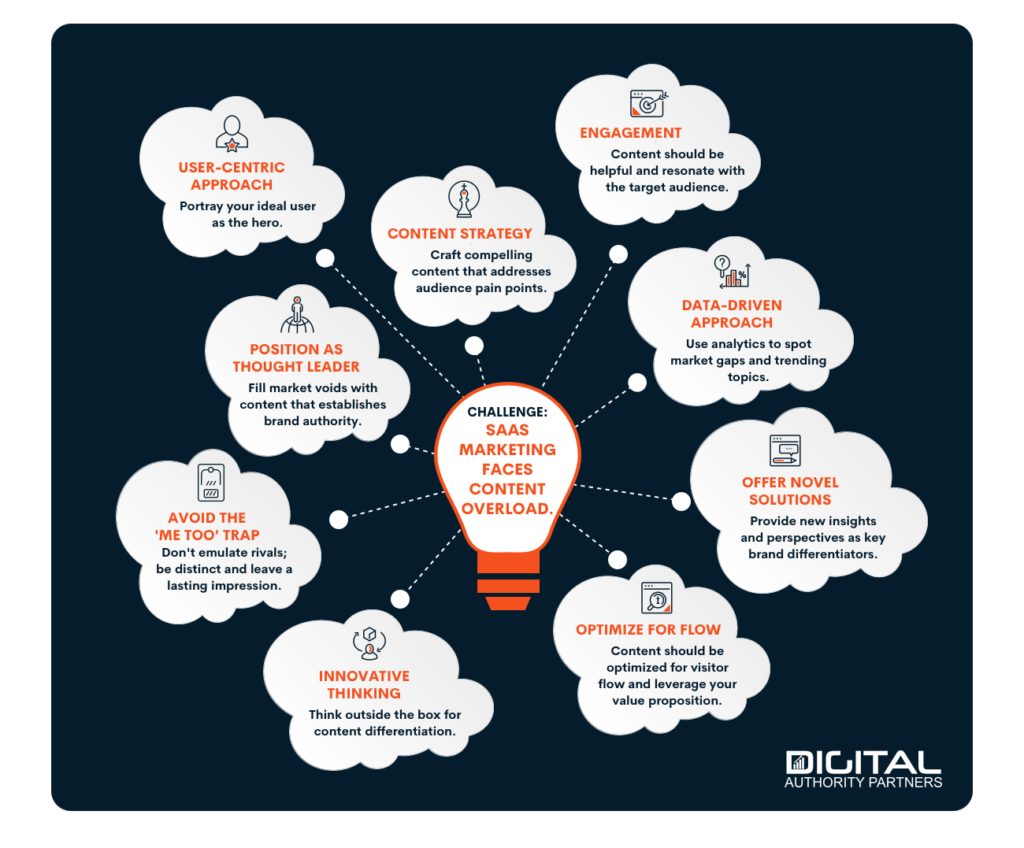
An ROI-driven content approach will go a long way in helping you navigate this challenge. You want to craft content that cuts through the noise right from the start by presenting the specific statistics affecting your ideal customer - and showing how your solution definitively addresses all those challenges.
With this approach, you will also avoid succumbing to the 'me too' content trap - a significant SaaS marketing challenge right now. You cannot just emulate what your rivals are doing -- your website will be filled with “I’ve seen that before” content and will not leave a lasting impression on your target audience.
Instead of churning out generic content, paint your ideal user as a hero. Focus on content optimized for visitor flow and leverage your value proposition as the “perfect solution” to the problem your customer is facing. These SaaS homepage tips can also work well with landing pages, product detail pages, and even blogs.
As a forward-thinking SaaS brand, you will get the most out of your content efforts if you think outside the box. Your content strategy should focus on new and innovative solutions, insights, and perspectives that will serve as the key differentiators for your brand.
To truly be at the top of the game, use data and analytics to identify market gaps and trending topics in your niche. This data-first approach will be pivotal in creating content that positions your brand as a thought leader.
3. Invest in the Right Marketing Technology Platforms
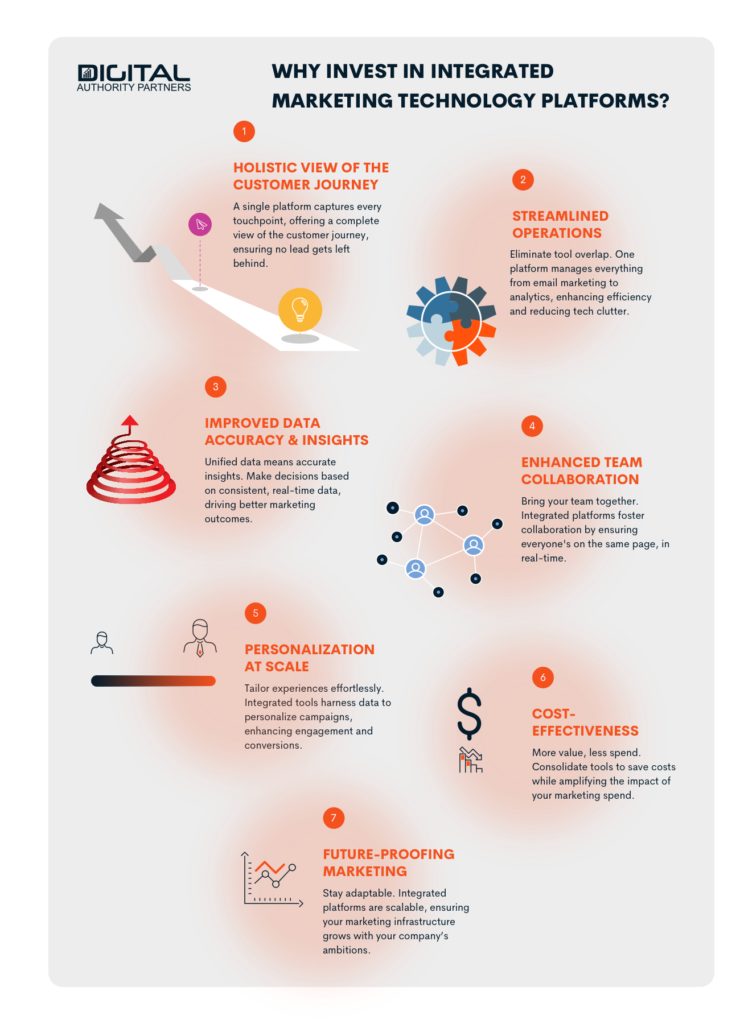
According to Forbes Magazine, Artificial Intelligence, and SaaS products are on the verge of disrupting, or even taking over, large parts of our economy. This can be a concern for SaaS brands, because maintaining a good handle on the rapidly shifting technology space can be difficult.
You may have built a future-proofed SaaS product, but if you are not using the right tech stack in your marketing, it will be rather worthless.
Here are the top reasons why you need a robust marketing tech stack:
Streamlined Operations:
Embracing the rapidly-shifting technology landscape can be a challenge, even for seasoned SaaS brands. The best SaaS companies can steer companies to the best ways to consolidate everything from email marketing to sophisticated analytics. They can also seamlessly connect your customer relationship management (CRM) with your marketing management software, to reduce redundancy and tech clutter.
Improved Data Accuracy & Insights:
In an era where real-time, accurate data is gold, integrated platforms stand out. With the best data, brands can craft marketing strategies based on consistent insights, resulting in better outcomes. This is especially critical as SaaS companies venture into workshops, webinars, and conferences to stay ahead of emerging trends and challenges.
Enhanced Team Collaboration:
One cannot overstate the importance of alignment in marketing. When salespeople, marketers, and other stakeholders operate from a unified platform, they can work collaboratively with enhanced communication. The result is better outcomes. Everyone stays updated, in real-time, ensuring a cohesive approach to address the dynamic needs of the SaaS market.
Personalization at Scale:
Today's digital consumer is looking for more than another solution partner; they crave personalized experiences. The power of integrated marketing platforms shines brightly here, enabling brands to leverage vast data sets that make it easier to target the right buyer personas at the right time. This paves the way for tailored campaigns that meet individual needs, thus fostering deeper connections that drive engagement and loyalty in a digital landscape that often feels detached.
Cost-Effectiveness
SaaS brands should evaluate not only the potential of their marketing tools but also their cost implications. By consolidating tools under one roof, companies can amplify the impact of their marketing dollars.
Future-Proofing Marketing:
The digital world is constantly in flux.
As SaaS companies invest in acquiring new customers, their marketing infrastructure should be adaptable and scalable. Integrated platforms ensure that marketing tools evolve in tandem with a company's ambitions and are always poised for future growth.
4. Market to Acquire New Customers and Retain Existing Ones
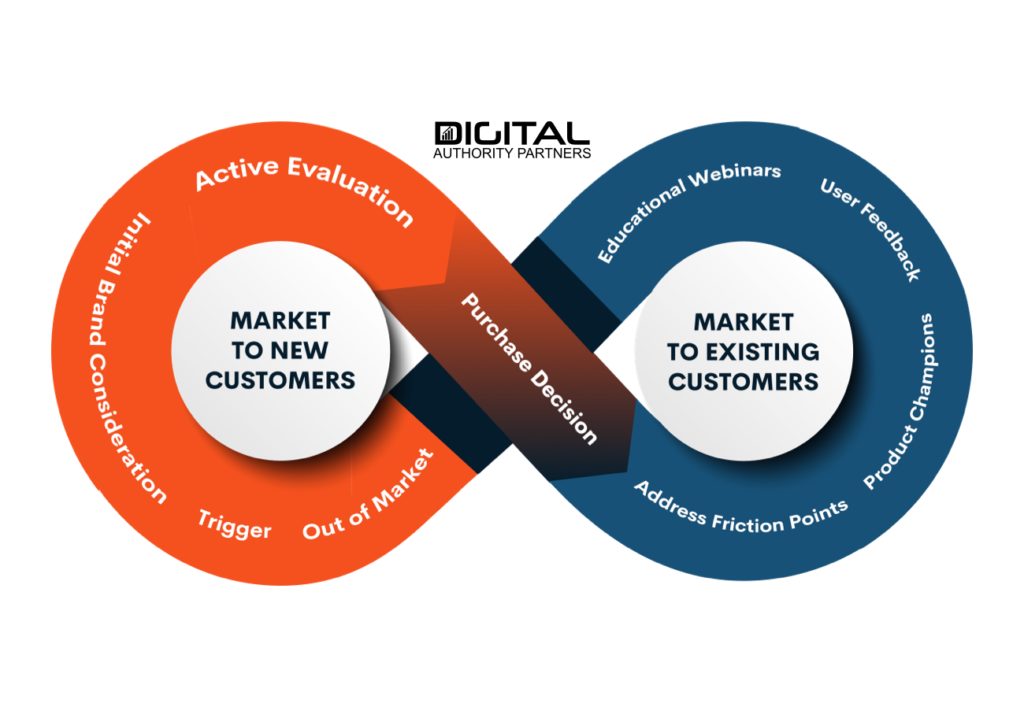
Traditional marketing places greater emphasis on new customer acquisition. SaaS marketing, however, calls for a two-pronged approach that leans more heavily on retaining existing customers without neglecting MQL growth.
Striking the right balance between these two crucial touchpoints is one of the most delicate SaaS marketing challenges marketers face. Securing new qualified leads is vital for growth, but cultivating long-term relationships is equally crucial to a SaaS company's success.
The real challenge is to create a strategic plan that ably balances these two audiences. One of the biggest considerations is the cost of acquiring new customers versus retaining existing ones.
The retention end of CRM can translate to lower costs because you have already established a relationship and familiarity with those clients.
However, SaaS companies must invest substantial time and resources into marketing campaigns, lead generation, and sales efforts to win over new customers.
Creating strategies that cater to both customer acquisition and retention can be challenging. Properly weighing the balance requires a comprehensive understanding of your target audience, their needs, and a thorough knowledge of their concerns at different stages of the buyer's journey.
By segmenting your audience and tailoring your strategies accordingly, you can effectively allocate resources to attract new customers while providing the value and support needed to retain existing ones. Do not fail to regularly evaluate customers' lifetime value and weigh the acquisition costs against the potential revenue generated from long-term customer retention.
5. Avoid Marketing Vanity Metrics, Focus on Real Value Metrics
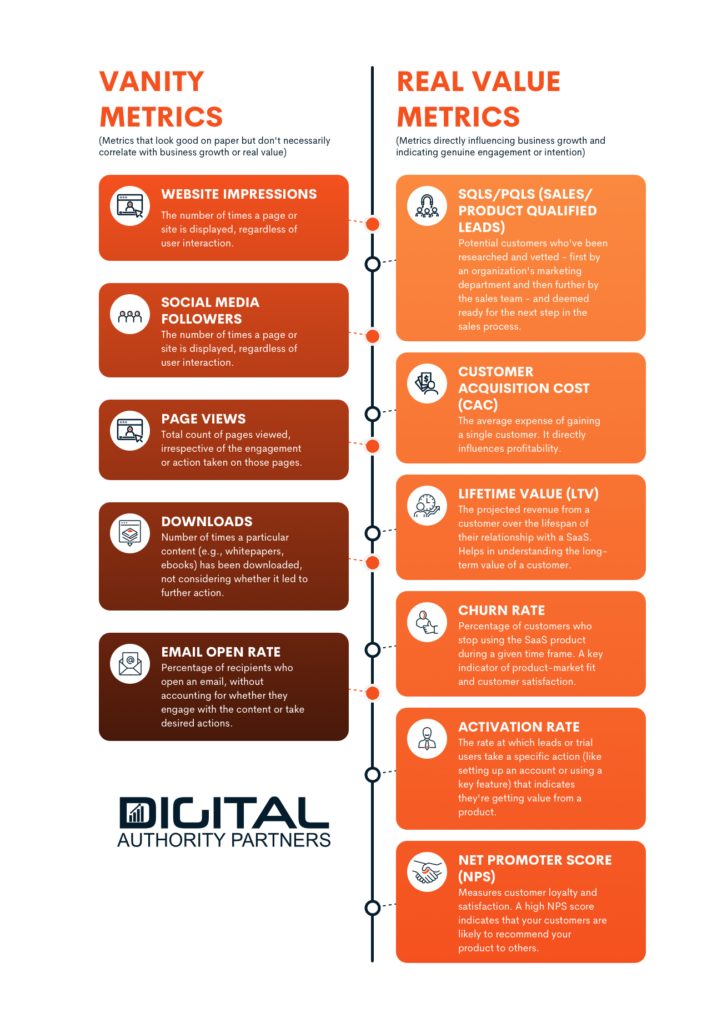
The influx of data in modern marketing is a double-edged sword for SaaS marketers. Although siloed data can help you tap into valuable insights and opportunities to fine-tune your marketing campaigns, it can also overwhelm your teams and result in analysis paralysis.
Getting organizational alignment on which metrics matter and extracting actionable insights from the vast amount of data available has become one of the most critical SaaS marketing challenges.
Most SaaS companies do a bad job at this - especially the larger SaaS organizations!
Another oft-overlooked SaaS marketing challenge is drawing the line between meaningful and vanity metrics.
While website traffic, social media following, email open rates, or whitepaper download rates may look impressive numerically, they do not necessarily translate into tangible outcomes for your SaaS business.
This is especially true for SaaS startups with buzz-worthy slogans. It pays to find and measure metrics that actually provide meaningful insights into customer behavior, conversion rates, and revenue generation. Some of these metrics include SQLs/PQLs, Customer Acquisition Costs, Lifetime Value, Churn Rate, Activation Rate, and Net Promoter Score rates. If you're a SaaS startup looking for help with your marketing efforts this year, consider visiting our Fractional CMO for Startups page for more details or checking out the work we’ve done for DecisionLink and Cove Markets.
When you focus more heavily on meaningful metrics, you can make data-backed decisions that fuel the best results. With multiple platforms and tools tracking different metrics, you want to start by defining KPIs in tandem with your marketing objectives.
A structured data analysis strategy will help you prevent analyst burnout and focus on insights that truly matter to your bottom line. It is a low-cost approach to overcoming data overload and analysis paralysis, as per Forbes.
6. Retain Customers Through Ongoing Marketing
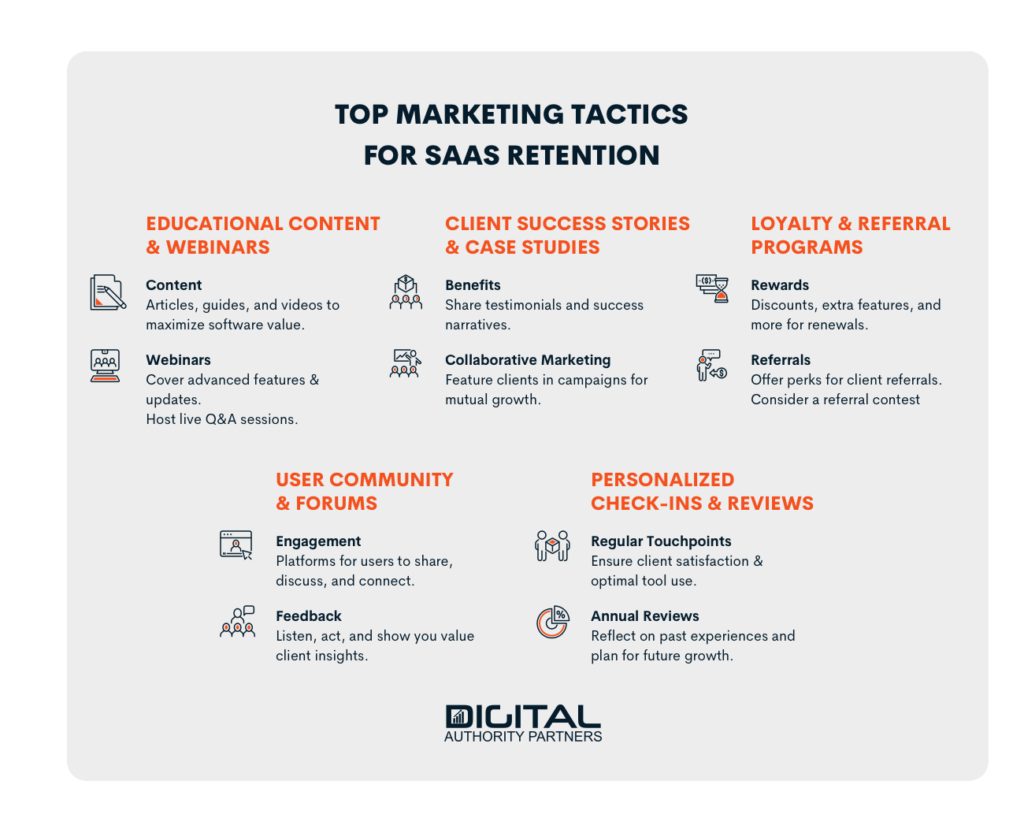
Close to four percent of unhappy customers air out their complaints. More than nine out of ten unhappy non-complainers quit, according to an annual survey conducted by the well-respected researcher, Estaban Kolsky.
The message is clear: managing customer satisfaction can make or break your SaaS brand. That brings us to one of the most neglected yet obvious SaaS marketing challenges: managing customer expectations.
There is no better way to manage expectations than marketing with a definite plan to keep current clients happy and to increase overall retention rates when it is time to renew a contract.
Here are the most common marketing tactics every SaaS company should employ to keep clients happy.
Educational Content and Webinars:
Content: Regularly release articles, how-to guides, and videos that teach clients how to derive more value from your software. This not only helps existing clients exercise the full potential of your SaaS tool but also deepens their reliance on it. In fact, there is no bigger threat to your SaaS platform retention than customers who do not actively use your software.
Webinars: Host webinars that cover advanced features, new updates, or best practices. Consider holding Live sessions to offer a platform for customers to ask questions and share feedback.
Client Success Stories and Case Studies:
Showcase Benefits: Document success stories from clients who have greatly benefited from your product. These case studies serve as testimonials to other clients of the potential your SaaS solution holds. Consider featuring some clients in your monthly newsletters by sending these testimonials to your existing client list. In-depth testimonials can be turned into whitepapers and shared with other customers with similar profiles and buyer personas!
Collaborative Marketing: Feature your clients in your marketing campaigns, which can provide them with exposure and strengthen your relationship with them. These samples of collaborative marketing techniques can be used to retain existing clients and to generate new business.
Loyalty and Referral Programs:
Rewards: Offer incentives such as discounts, extended features, or promotional items for clients who renew their contracts. Consider providing additional rewards for long-term customers.
Referral Programs: Encourage your current clients to refer other potential clients by providing benefits such as discounts, feature upgrades, or other perks. Consider running a contest among your current clients and reward the ones who sign up the most new clients.
User Community and Forums:
Engage and Support: Create a platform where users can share tips, provide solutions, or discuss best practices. This helps create a sense of community and demonstrates that you care about client success.
Feedback Loop: Use these platforms to gather feedback about your product and make improvements. Demonstrating that you listen and act on feedback can drive loyalty.
Personalized Check-ins and Reviews:
Regular Check-ins: Have your customer success team conduct regular check-ins with clients to ensure they are satisfied and putting all available tools to effective use.
Annual Reviews: Organize yearly (or bi-yearly) reviews so that clients can discuss their experience: challenges they faced, and how they can get more out of your service in the upcoming year. This provides an opportunity to preemptively address concerns and reinforces your service's value.
All these marketing strategies designed to engage with existing clients can cultivate robust, long-lasting customer relationships.
7. Global Competition and Localization Challenges
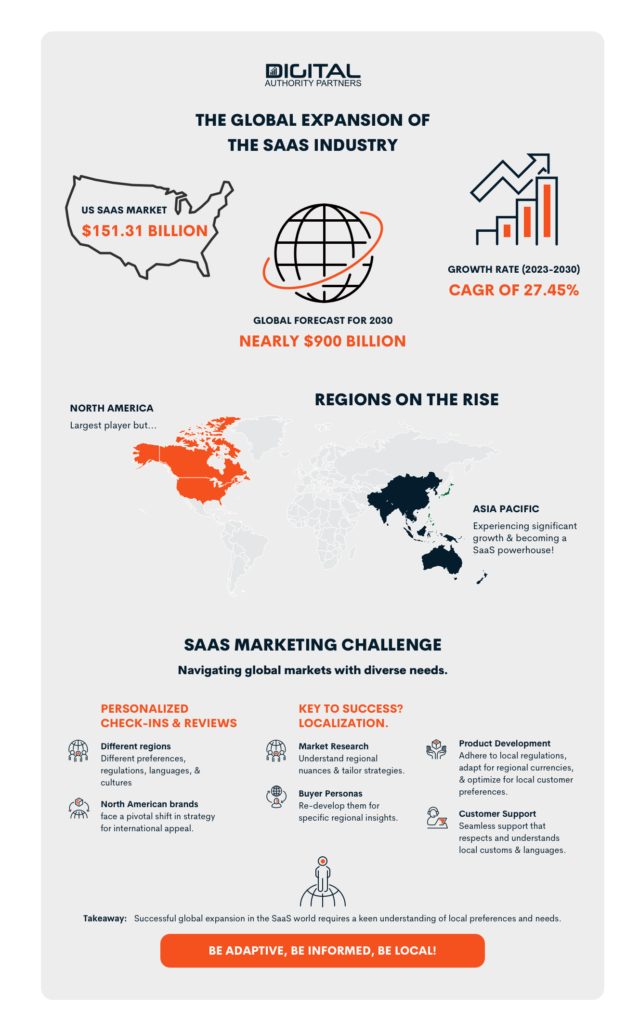
The $151.31 billion US segment makes up the most significant portion of the global SaaS industry. Still, other players outside North America have steadily gained more influence over the last ten years. The global market size is forecast to hit close to $900 billion by 2030, with a CAGR of 27.45% in the 2023-2030 period.
A sizable chunk of that growth will likely come from Asia. That makes navigating global markets with diverse needs an increasingly pressing SaaS marketing challenge, especially for North American brands.
As SaaS businesses expand their reach across borders, adapting strategies for different regions to effectively address the localization challenges that arise becomes ever more critical.
One of the most challenging issues is identifying and optimizing for customers' specific preferences and needs in different regions around the world.
Adjusting to unique regional differences in regulations, language, and culture can significantly influence how your SaaS services are utilized and perceived. You must conduct top-down market research and develop buyer personas afresh to gain insights into their specific needs and tailor your strategies accordingly.
Localization challenges can also touch on your customer support and product development best practices. You should build your strategy and product from the ground up to align with local regulatory frameworks, currencies, and other nuances that can make for a seamless user experience (UX).
Strategies to Address and Overcome SAAS Marketing Challenges
(1) Adopting Agile Marketing Approaches
In the SaaS industry where competition is fierce, your ability to be flexible and adapt is crucial for marketing success. Putting agile marketing strategies into motion lets you stay one step ahead of the curve and execute lightning-quick responses to market shifts.
Many SaaS brands know that having a strong understanding of customers can make all the difference. Still, they do not have the tools and expertise to translate that knowledge into innovative marketing campaigns - and results. A Fractional Chief Marketing Officer (FCMO) can be instrumental in providing these for a reasonable cost.
Plenty of promising statistics support hiring the best SaaS fractional CMO:
- 95% of SaaS brands that contract with a FCMO are happy with the outcome and plan to continue that strategic relationship.
- A leading FCMO can boost lead generation by 300% for a sales SaaS product brand.
- The agility and flexibility offered by an FCMO are appreciated by 95% of businesses.
- SaaS companies can realize a marketing ROI uptick of up to 4x when they hire an FCMO
- An FCMO can help businesses achieve average revenue growth of 27%. This figure could be much higher if you employ proven SaaS Fractional CMO tips and best practices.
When you make use of tried and true B2B SaaS SEO strategies, your SaaS company can easily navigate the complex marketing landscape. Any FCMO you hire should bring a wealth of expertise and insights to the table, helping drive growth and boost revenue.
With an FCMO, your SaaS company will gain access to a pool of experienced marketing talent. These executives deeply understand the SaaS industry and can create a powerful marketing strategy tailored to your business.
They provide expert guidance and training to empower your team with the skills and insights needed for highly effective campaigns. Furthermore, an FCMO enables real-time response to market changes.
A good FCMO agency can quickly analyze data, identify trends, and adjust marketing strategies accordingly. With this agility, your SAAS company can seize opportunities and stay competitive in a rapidly evolving market.
(2) Emphasizing Customer Education and Value
Putting customers first is a failsafe marketing strategy for any industry; the SaaS sector is no different.
Emphasize customer value and education to make your most valuable asset, your customers, feel appreciated right out of the gate.
When you create worthwhile resources for your customers, your brand can not only survive but thrive in this competitive industry. The same is true of fostering trust and credibility.
You establish your SaaS brand as a thought leader and trusted advisor when you create free trials, white papers, documentation, and other tangible resources.
Go beyond blog posts – create engaging videos and comprehensive guides that provide valuable insights and solutions to your target audience's problems and concerns.
Showcase customer success stories, testimonials, and case studies that highlight your SaaS solution's positive impact on businesses. This demonstrates the value of your product and instills confidence in potential customers, making them more likely to choose your brand over a competitor's.
(3) Leveraging Automation and AI for Data Analysis
Although Wall Street Journal says companies are overwhelmed by an avalanche of new AI roll-outs, great potential lies in the data analysis. This is especially important for SaaS companies that want to whittle down the impact of data overload.
SaaS brands can leverage modern automation and AI tools to extract powerful insights from their data to refine and optimize campaigns continuously. Automated data collection and analysis allow marketers to process huge volumes of structured and unstructured data from multiple touchpoints like websites, emails, social media, and more.
Advanced AI algorithms then scour this data to reveal patterns and identify opportunities that may not be obvious to human analysts alone. Whether pinpointing high-intent segments within prospects, determining the most effective content types, or predicting which campaigns will convert best - AI-powered insights provide an objective view of what is truly driving results.
Armed with these findings, marketers can make data-backed decisions to refine messaging, prioritize campaigns, and allocate budgets precisely where they will generate the highest returns.
Summing Up
SaaS marketing is a complex and challenging field that requires careful, continuous planning and execution. The most pressing SaaS marketing challenges include:
- Understanding and targeting the right audience
- Working with content overload
- A rapidly changing technology landscape
- Balancing customer acquisition and retention
- Data overload and accompanying analysis paralysis
- Managing customer expectations
- Navigating global markets.
To successfully navigate these challenges, you must put several strategies in place. These include conducting thorough market research and developing detailed customer personas to understand your target audience better.
Craft compelling and unique content that cuts through the noise and showcases the value of the SaaS solution. You should also stay informed about emerging technologies and attend industry events to adapt marketing strategies to meet best practices appropriately.
Do not forget to strike the right balance between customer acquisition and retention when weighing costs and potential revenue. Making good use of automation and AI tools for data analysis to extract valuable insights can also go a long way.
Forward-thinking SaaS companies manage customer expectations by setting realistic goals and showcasing the benefits of their services. Adapting local buyer personas, embracing cultural differences, and optimizing for different regions can go a long way to help you successfully navigate global markets with diverse needs.
Want To Meet Our Expert Team?
Book a meeting directly here




